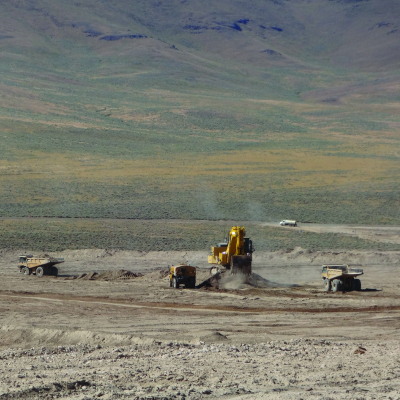LITHIUM DISCOVERY ENERGIZES CALIFORNIA

OVERVIEW
As global warming continues to jeopardize our precious land on Earth, we are quickly running out of effective renewable energy sources that can replace the burning of fossil fuels and the abundance of greenhouse gas emissions. However, the solution to this terrifying problem may be within reach.
The Salton Sea, born in the heart of Imperial Valley in California, is known for its ecological significance and unique geothermal features. Recent discoveries have shown another treasure hidden beneath its surface: lithium.
As Thousand Oaks and other cities in California begin to navigate their transition towards sustainable energy sources, lithium presents a compelling opportunity for California’s energy landscape. This abundant metal is crucial for powering electric vehicles and storing renewable energy, and can be implemented in a number of ways. Not only can lithium offer potential economic benefits, but it also serves as a sustainable solution to power demands in this new era of clean energy.
CLIMATE AND ENVIRONMENTAL ACTION PLAN
On March 18, the City of Thousand Oaks released its draft Climate and Environmental Action Plan (CEAP), inviting residents to read and submit public comments until April 23. The plan details the specifics of the city’s sustainability and climate change mitigation efforts within the 2045 General plan, which was adopted in December of last year.
The primary goal of the CEAP is to reduce the city’s greenhouse gas (GHG) emissions by 85% by the year 2045. Greenhouse gasses contribute to global warming by trapping heat in the atmosphere; the result is dubbed the “greenhouse effect”. GHG emissions, otherwise known as carbon emissions, are a primary cause of climate change which will and already has had disastrous effects on the planet.
Gasoline is a large emitter of GHG, and as a result, the state of California has made it a target to become a leader of green energy and in reaching carbon neutrality by 2045. In order to achieve this, Governor Gavin Newsome signed an executive order in 2020 prohibiting the sale of carbon-emitting cars by 2035, as they account for 35.3% of the state’s total carbon emissions. In Thousand Oaks transportation accounts for 63% of its carbon emissions.
The draft CEAP outlines one of Thousand Oaks strategies to reduce car usage by prioritizing the development of sidewalks and better bike infrastructure. By 2030, the city plans to construct around 2.5 miles of new sidewalk, and an additional 2.2 miles are planned for 2045. Additionally, 9.2 miles of bike lanes will be converted into class IV separated bikeways by 2030. That same year, the city would also build 2.5 more miles of new bike lanes, and 7 more miles by 2045. Furthermore, the plan includes adding 10 miles of bike lane safety improvements in 2030, followed by 14 additional miles by 2045.
Acknowledging the city is inherently reliant on automobiles, the draft CEAP emphasizes public transportation as a method of reducing individual carbon footprint. The city aims to transition its fleet of city owned cars to 100% electric by 2027.
The city intends to only purchase additional electric buses for its transit program by 2029 the city hopes to increase its ridership by 20% in 2030. However, the plan does not explicitly mention if the city will continue with the operation of its current natural gas carbon emitting bus fleet.
To accommodate the energy demands of this electric fleet and transit system, the draft CEPA requests approval from Southern California Edison in 2026, to build electric car and bus charging installations in the Civic Arts Plaza, Transportation Center, and municipal service center, which are expected to be finished by 2028.
In order to support the state’s climate goals the draft CEAP stresses the city’s role in electrification and setting up charging infrastructure. This infrastructure will primarily help residents in multifamily developments or apartment complexes who possibly could lack home EV chargers and must share parking spaces.
The California Energy commision (CEC) aims to build 1.2 million public and shared charging stations throughout the state by 2030. The draft CEAP calculated that the city would have to build 2,966 charging stations by 2030. Currently, the city has 172 public charging stations, including various levels of chargers such as level two and three chargers. There are an additional 125 planned for the coming year.
The draft CEAP noted that seven of the largest multi-family complexes in the city, totaling to 1,500 dwelling units,were lacking EV parking infrastructure. To address this, the draft CEAP outlines a 2025 plan to create an outreach team to communicate with over 1,000 low income residents. The draft CEAP also recommends placing public EV chargers near these developments that might not be able to facilitate an EV charging infrastructure due to spacing and power allocation.
By 2026, the city plans to increase electric vehicle charging parking spaces in newly developed multifamily developments such as condos or apartments. However, the draft CEAP notes that the California Green Building Standards code (CalGreen) has insufficient requirements for EV parking spaces in multifamily developments. As a result, the draft CEAP intends on increasing the number of required EV space beyond this requirement.
The city is actively involved in developing public charging stations; the draft CEAP recommends also exceeding the minimum CalGreen requirement for EV charging stations in non-residential commercial areas. By 2026 the city aims to have at least 25% of parking spaces equipped with EV charging outlets, and 20% of parking spaces capable of future charger installations. Additionally, the city aims to complete several charging installations at key locations like the civic arts plaza, transportation center, and libraries by 2026.
By 2030, the city plans to support the upgrades of existing parking lots in the city’s permitting system, however, it would now require EV-capable spaces to be built before the repaving of commercial parking lots. This is part of the city’s response to the new law, (AB 970, 2021), which set a short 20-40 day approval deadline for the construction of EV charging stations. The draft CEAP also states, “Under this law, if an electric vehicle charging station impacts the required parking spaces for existing uses, the City must reduce the number of required parking spaces for the existing uses accordingly.”
The draft CEAP ends by acknowledging it’s not projected to meet its 2045 goals of reducing GHG emissions by 85%. The CEAP expects to surpass its goals of a 42% reduction by 2030, as by 2045 it notes the city should experience a 59% reduction rate. Nevertheless, the state is moving forward in its push to reduce California’s carbon footprint while the demand for electric car infrastructure continues to grow day by day.
THE PROCESS OF MINING
One of the ways that lithium can be extracted from the earth is through rock mining, and this is the process that Australia uses. Companies cannot mine lithium directly, so they mine spodumene, a mineral that is rich with lithium. The process of mining spodumene creates more carbon dioxide than evaporation ponds, by almost 3.5 times. Because of the damage that this method of extraction does to the earth by the removement of soil and trees, environmental activists have been reluctant to adopt it as the clean energy mechanism it has been marketed as.
In California, Salton Sea, specifically an area close to it known as Lithium Valley, has become a prospect for lithium mining companies, hence why a recent tax for lithium that is mined in CA was created. Gavin Newsom, governor of California, through the power of legislation, allotted $5 million to Imperial County, the county that holds Lithium Valley in its jurisdiction. The revenue generated is meant for environmental projects and also the counties that host the mines. According to the US Dept. of Energy, the lithium found around Salton Sea would be able to make batteries for 375 million electric vehicles. Newsom is eager to make California a “global hub for clean energy”, and draws a distinction that extraction methods used will not include rock mining, and instead will use “modern extraction techniques”. Up to this point, Australia, Chile and China have been the top lithium producing countries, with the US being excluded from the top 10 list. With a successful rollout of Newsom’s plans, California could influence other lithium producers to use better extraction technology. Additionally, lithium’s global industry is expected to expand from $26.88 billion in 2024 to $134.02 billion in 2032.
KORE Mining has plans of collaborating with the Torres Martinez Desert Cahuilla Indians [TMDCI] for the creation of economic ventures with a focus on sustainability in Lithium Valley. Lithium Valley will be part of their natural resource exploration. (Source) Unfortunately, this collaborative effort contrasts with Lithium America’s [LA] project in Thackers Pass, Nevada, in which LA had legal battles with conservationists and Native American tribes. The People of Red Mountain and Reno-Sparks Indian colony argued that because their ancestors were killed in the Thackers Pass massacre of 1865, a lithium mine in the area should not be allowed, citing disrespect of sacred land, and violations of the National Historic Preservation Act.
ENVIRONMENTAL IMPACTS
For a long time fossil fuels such as oil and gas have been the main source of energy for cars, houses and other technology, however in recent years scientists started creating more eco friendly sources of energy using resources such as lithium. Lithium (an alkali metal on the periodic table) is one of the many new technologies that creates clean energy which is a little less polluting than fossil fuels. However, the process to produce the material can have damaging effects on our environment. In comparison to the production of fossil fuels, lithium mining results in less pollution, but that does not mean it does not have any effect on the environment at all. In fact, it actually has a number of effects that can damage the ecosystem.
One of the major effects is the chemical damage. Jared Naimark, an employee of Earthworks, a nonprofit organization dedicated to protecting the environment, explained that the chemicals used in lithium mining can be extremely harmful to the environment. “There’s also some significant issues of chemical hazards. They are using sulfuric acid as a processing step to remove that lithium from the clay deposit. And that can lead to some serious air quality and toxic emissions,” Naimark said. Chemical impacts can be devastating, especially since they can lead to serious health problems for exposed animals and humans. Unfortunately, chemical effects are not the only cause of concern in lithium mining. There have already been numerous incidents where mining sites have had waste affect communities close to the sites. “There’s been a number of disasters where tailings facilities can collapse or partially collapse leading to toxic material running off into the environment, or in some cases, death and illness and communities who are living downstream and get basically hit with a tidal wave of mine waste,” Naimark said.
While lithium mining produces green energy, incidents and chemical hazards raise the question of whether or not it is really helping the environment. Doctor Sean Anderson, California State University Channel Islands environmental science professor, believes that despite environmental impacts, lithium mining will help reduce climate change. “I understand that this has some downsides for this group of folks or these critters in this area. But the bigger concern is climate change, if we don’t get a handle on this transition to a cleaner economy,” Anderson said. The impacts of lithium mining are no small thing however in comparison to oil and fossil fuel production, lithium has less of an environmental impact.


